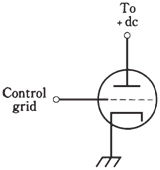The triode
In the diode tube, flow of electrons from cathode to plate depends on the dc power supply voltage mainly. Greater this voltage, greater will be the current through the tube.The flow of current can be controlled by an electrode between the cathode and the plate. This electrode, known as control grid, is a wire mesh or screen which allows electrons physically pass through. But control grid (called simply the grid) interferes with electrons if it is provided with the voltage which is negative with respect to ground. The greater the negative grid bias, the more the grid impedes flow of electrons through tube.
A tube with the control grid, in addition to the cathode and plate, is a triode. This is shown schematically in the figure given below. In this case, cathode is indirectly heated; filament is not shown. This omission is almost standard in schematics showing tubes with the indirectly heated cathodes. When cathode is directly heated, the filament symbol serves as cathode symbol.

Figure--Schematic symbol of triode tube. The filament is not shown.
Now you see the resemblance between a triode tube and an N-channel FET. The cathode is similar to the source; the grid is analogous to gate; plate corresponds to drain. The major differences, between triode tube and N-channel FET are that the tube is constructed differently, and tube works with higher voltages.In a tube amplifier, the control grid is where signal input is applied normally. A triode amplifier or oscillator circuit looks like an FET circuit, except the tube plate and grid bias voltages are greater than FET drain and gate voltages.